Log in or create new account to save this product to your wishlist.
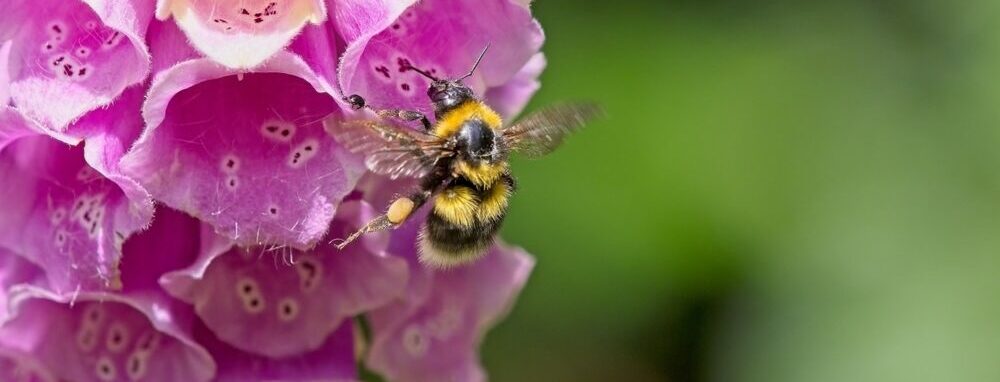
How to Grow & Care for Foxglove Plants
Beautiful but toxic. Foxglove plants are garden favourite, as long as no one nibbles on it. Find out how to best nurture this plant!
🌱 All important maintenance moments for your lawn during the year. Leave your email and we will send you the lawn calendar for free.
Enter your email
Receive the lawn calendar in the mail
Enjoy a green lawn all year round!

- Order by 2PM = shipped today
- 250.000+ satisfied customers!
- 60 day satisfaction guarantee
Do you love those beautiful bowing spikes of bell-like blooms that spread so plentifully throughout the British countryside? Indeed, foxglove plants are stunning biennials that attract pollinators like bees and butterflies and, if you get the conditions right, are easy to grow in even shady parts of your garden.
- What is a foxglove plant?
- The biodiversity of foxgloves
- Beware! Foxgloves are poisonous
- What conditions does a foxglove plant favour?
- How to plant foxgloves
- Foxglove plants – care tips
- Foxglove plants with other flowers
- How to control spreading foxglove plants
- FAQs
Native to Western Europe, the Digitalis purpurea has become widespread around the continent and beyond — and not just in the wild! The stunning bell-shaped blooms are certainly a feast for the eyes and have become a distinct favourite in British gardens.
This article explores how to grow and care for foxglove plants, with plenty of tips to get your beds blooming with these stunning wildflowers.
Ready? Let’s go!
What is a foxglove plant?
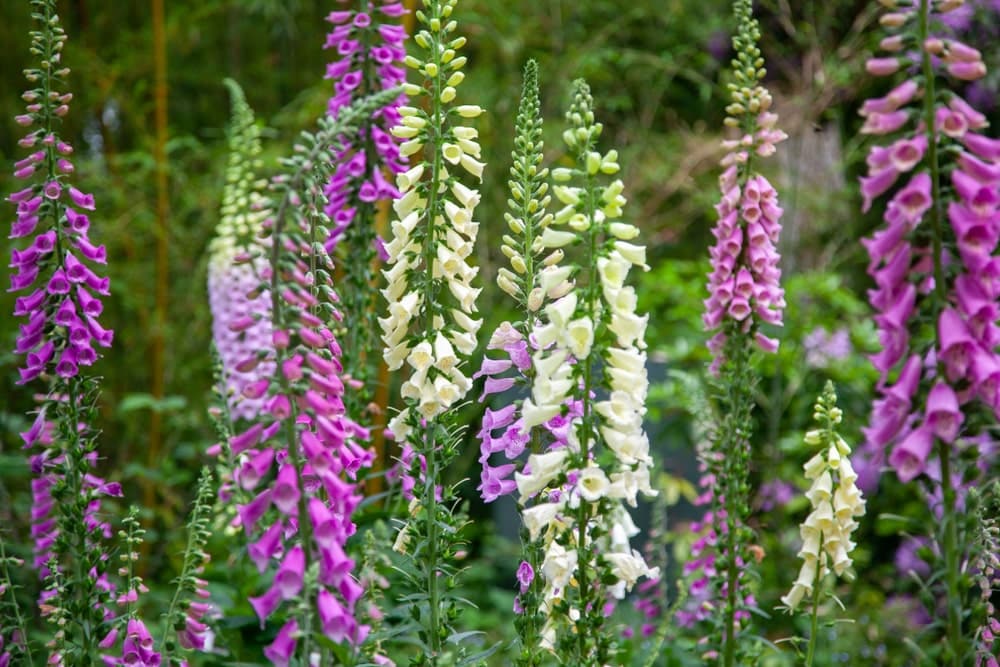
Foxgloves are instantly recognisable, identified by their tall stems, from which an abundance of bell-shaped blooms hang.
Here are some foxglove facts to get us started:
- Family: Plantaginaceae
- Modern habitat: Western and Northern Europe, North Africa, West Asia
- Location: Sunny to semi-shaded locations with humus-rich, acidic and loose soil
- Growth period: Biennial — a typical foxglove’s lifespan is over two years, flowering most abundantly in the second year.
- Growth form: Herbaceous plant
- Height: Up to 2 m
- Leaves: Ascending, lancet-like leaves
- Flowering period: June to August
- Flowers: Eye-catching, grape-like inflorescences in different colours
- Reproduction: A prolific self-seeder. With a bit of luck, your foxgloves will drop their seeds, spreading and reproducing over time.
The biodiversity of foxgloves
The foxglove plant has over 20 main species. The most commonly found in the UK are:
- Digitalis purpurea — with pinkish-purple flowers
- Digitalis lutea — with yellow flowers
- Digitalis grandiflora — the large-flowered variety
While each species differs in the colour and proliferation of its flowering, the care and conditions remain largely the same:
The lifespan of a foxglove plant
In the first year, the plant develops its foliage, growing as tall as 2m high. In the second year — between June and August — the plant produces multiple flowers along the stem, each bloom sporting a distinctive lower, spotted lip.
Then, after flowering, the flowers drop, and the plant produces fruit, which eventually dries out on the stem.
Beware! Foxgloves are poisonous
Despite their beauty, foxgloves are particularly toxic to humans, so we recommend keeping them away from areas of your garden in which your children are likely to play.
All parts of the plant are poisonous to both humans and pets — even eating a few leaves can be fatal. The plant contains naturally occurring toxins harmful to the heart.
However, recorded foxglove plant poisonings are relatively rare.
What conditions does a foxglove plant favour?
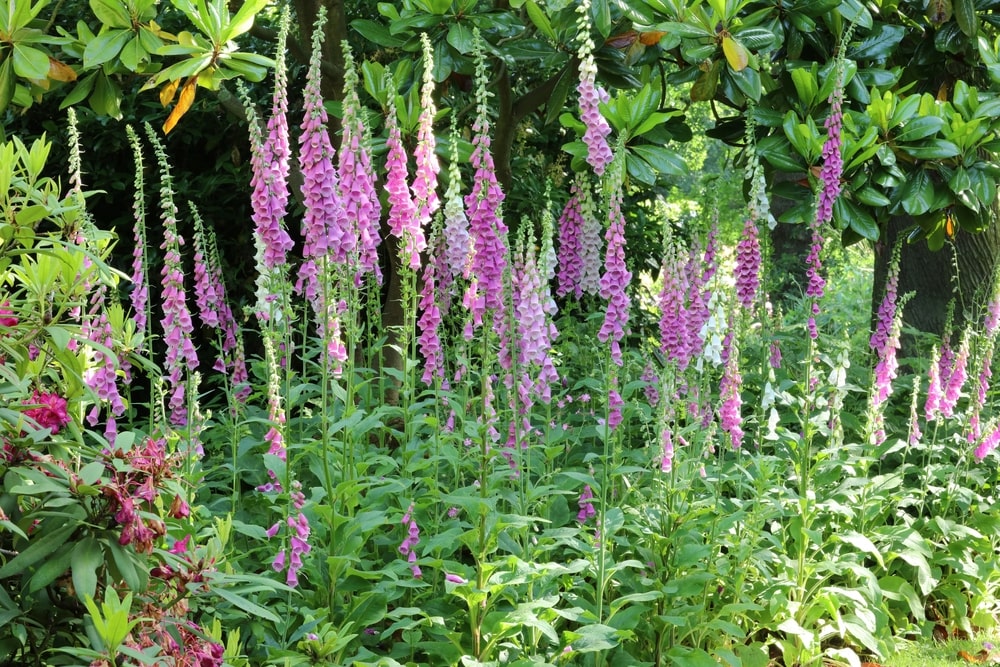
These plants prefer dark, nutritious, crumbly soil composed of fully decomposed organic matter, otherwise known as humus-rich soil, containing a balance of silt, clay, and sand particles.
Foxgloves prefer partial shade but do well in full sun as long as the soil remains sufficiently moist.
However, most foxglove varieties grow in any reasonable soil as long as it’s neither bone dry nor waterlogged. They’ll even grow in well-draining shaded soil, but they won’t flourish in the same way.
How to plant foxgloves
You can buy foxgloves as small plants from garden centres or sow them from seed.
Plant young plants in groups of three to eight — they look gorgeous in clusters but avoid overcrowding. Space each plant 30cm apart.
If you have poor soil, improve the planting hole with organic material, and add a mulch layer of semi-rotten leaves around each plant to feed the new plants slowly.
You don’t usually need to fertilise a foxglove beyond providing decent soil conditions — but make sure the soil doesn’t dry out!
Foxglove plants – care tips
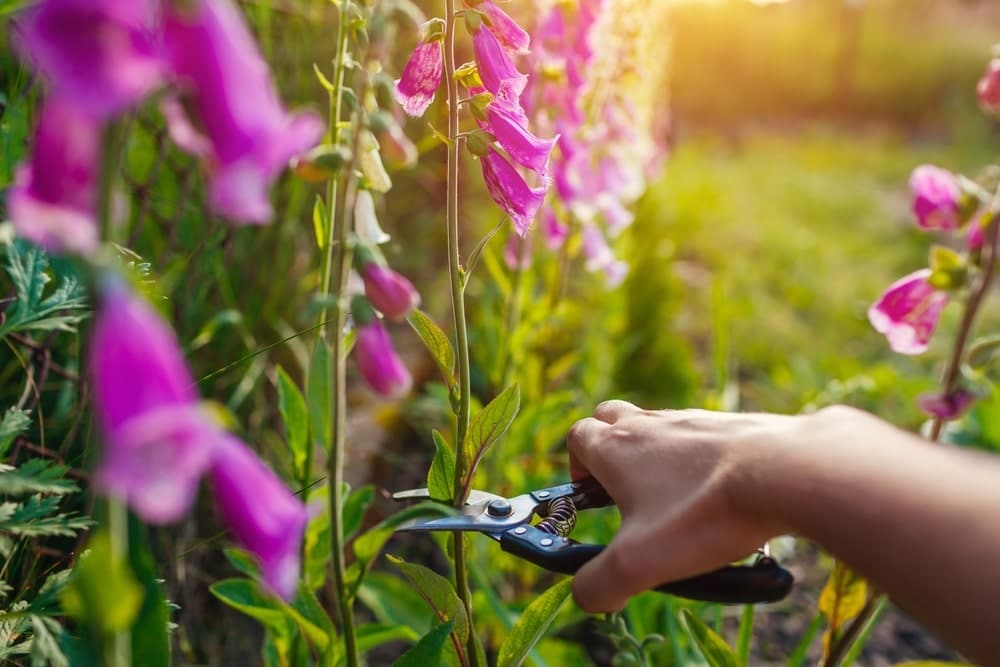
Most wild foxglove varieties self-seed once established and will grow with very little intervention other than to ensure the soil drains well and always remains moist (never waterlogged).
Over time, the plants will spread and may crowd the bed. So, remove excess seedlings and cut back the pods before they release their seeds to prevent excessive re-sowing. You can always dry out the pods and sow them in another part of your garden.
Foxglove plants with other flowers
Foxgloves are tall plants that grow nicely between spreading flowering plants, such as Rodgersia, Hosta, Rhodochiton (Purple Bells), bellflowers, and astilbes.
Many foxglove varieties have deep roots and grow well underneath trees, although they’ll only thrive with enough sun.
How to control spreading foxglove plants
These lovely plants quickly multiply, so you may need to regulate their spread.
Here are some ways to control the spread:
- Removal by hand: dig them out by hand — you can always transplant them somewhere else or give them to a neighbour. Dig up the entire root system to prevent regrowth.
- Mulching: spread well-rotted organic matter over your flowerbed soil to suppress the germination of new seeds.
- Mowing: foxgloves look pretty growing on a lawn, but mow them down before they produce seeds to prevent overpopulation.
FAQs
Foxgloves are highly poisonous to humans and pets. However, poisoning is rare. Remove them from play areas and keep them away from areas where your dog or cat may sleep. All parts of the plant are toxic, and ingestion can be fatal.
Most foxglove varieties bloom between July and September in the UK, producing large, trumpet- or bell-shaped flowers with a distinctive spotted lower lip. You can get foxgloves in various colours, from white, yellow, pink, or purple. However, the most common in the UK is the pinky-purple variety, known as Digitalis purpurea.
These are biennial herbaceous wildflowers, native to Western Europe but found worldwide in moist, well-draining soil. They produce bell-shaped flowers, growing along the entire length of the plant’s long stem. They can grow as tall as 2m and will self-seed, reproducing abundantly in the right conditions.
Any questions?
We hope we’ve provided all the tips you need to grow an abundance of beautiful foxgloves in your garden. But if you have any questions, don’t hesitate to get in touch.
And find out more about other wildflowers that might grow in your garden in our wildflower article.
Happy gardening!
-
How to Grow Eucalyptus in British GardensWith a little love and care, eucalyptus trees can thrive in English gardens. Since they don’t germinate well without proper help, there are not considered invasive. So, there is no reason not to plant them if you enjoy their looks.Read more
-
Transform Your Garden with All-Year-Round Flowering PlantsDid you know you can enjoy blooming flowers even in January? With the right selection of all year round plants, there’s no need to wait until spring to add some colour to your garden.Read more
-
How to Create a Butterfly Garden: A Simple Guide for British GardensThe UK's butterfly population includes 59 different species. These beautiful winged creatures face a steady decline because of habitat loss, pollution and changing weather patterns. Your garden can become a vital link between nature reserves and natural habitats. Let’s explore how.Read more
-
Volcanic Rock Dust for Your Garden—Application and TipsDid you know that volcanic rock dust is a brilliant organic soil improver? This article explains exactly what it's good for and how to use it properly.Read more
-
How to Use Landscape Fabric ProperlyIf weeds or erosion in your garden are troubling you, landscape fabric might be the solution. We’ll explain how and when to use it properly, just keep on reading.Read more
-
Hostas: A Complete Care GuideIf you have a north-facing garden or some shady corners on your property, hostas are the plants for you. These green delights thrive particularly well in partial to full shade and require consistently moist soil to perform at their best.Read more
-
How to Grow Grapes in Your Garden: A Simple Step-by-Step GuideGrapevines produce some tasty fruits, but often they are simply grown for their gorgeous leaves. Whatever your motivation may be, we have a guide on how to grow grapes for you.Read more
-
Worm Composting Made Simple: From Kitchen Scraps to Garden GoldDid you know that a single pound of composting worms can devour half their body weight in waste every day? That's roughly twelve pounds of kitchen scraps transformed into garden gold each month! We will look at how to make this happen.Read more
Leave a comment
Your answer will be displayed on the site and the interested party will be notified by email.
Leave a comment
Have a question or want to share your experience? Leave us a comment.

- Order by 2PM = shipped today
- 250.000+ satisfied customers!
- 60 day satisfaction guarantee

- Order by 2PM = shipped today
- 250.000+ satisfied customers!
- 60 day satisfaction guarantee

- Order by 2PM = shipped today
- 250.000+ satisfied customers!
- 60 day satisfaction guarantee

🌱 All important maintenance moments for your lawn during the year. Leave your email and we will send you the lawn calendar for free.
Enter your email
Receive the lawn calendar in the mail
Enjoy a green lawn all year round!












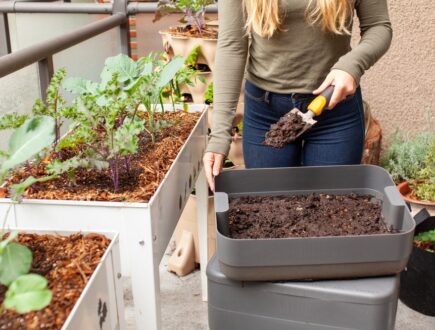








Comments (0)
There are no comments yet. Well then, what are you waiting for to
Be the first to write your comment!inaugurate this pretty page?
Do you have some comments?